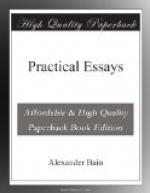After Erskine and Macaulay have yielded their first contribution to the oratorical student, he could turn with profit to Burke, who has the materials of oratory in the same high order as Macaulay, but who in the employment of them so often miscarries—sometimes partially, at other times wholly. It then becomes an exercise to distinguish his successes from his failures; to resolve these into their elementary merits and defects, according to the oratorical scheme. The close study of one or two orations is still the preferable course; and the most profitable transition from the Burke sample is to the selected speech or speeches of some other orator as Canning or Brougham. All the time, the pupil must be enlarging and improving his analytic scheme, which is the means of keeping his mind to the point in hand, amid the distraction of the orator’s gorgeous material.
The subsequent stages of oratorical study are much plainer than the commencement. A time comes when the pupil will roam freely over the great field of oratory, modern and ancient, knowing more and more exactly what to appropriate and what to neglect. He will be quite aware of the necessity of rivalling the great masters in resources of knowledge on the one hand, and of style on the other; but he will look for these elsewhere, as well as in the professed orators.
[EXAMPLES OF PERSUASIVE ART.]
Moreover, as the persuasive art is exemplified in men that have never been public speakers, the oratorical pupil will make a selection from the most influential of this class. He will find, for example, in the argumentative treatises of Johnson, in the Letters of Junius, in the writings of Godwin, in Sydney Smith, in Bentham, in Cobbett, in Robert Hall, in Fonblanque, in J.S. Mill, in Whately, and a host besides, the exemplification of oratorical merits, together with materials that are of value. It is understood, however, that the search for materials and the acquisition of oratorical form, are not made to advantage on the same lines, and, for this and other reasons, should not go together.
The extreme test of the principle of concentration as against equal application, is the acquirement of Style, or the extending of our resources of diction and expression in all its particulars. Being a matter of endless minute details, we may feel ourselves at a loss to compass it by the intensive study of a narrow and select example. Still, with due allowance for the speciality of the case, the principle will still be found applicable. We should, however, carry along with us, the maxim exemplified under oratory, of separating in our study, as far as may be, the style from the matter. We begin by choosing a treatise of some great master. We may then operate either (1) by simple reading and re-reading, or (2) by committing portions to memory verbatim, or (3), best of all, by making some changes according to an already acquired ideal of good composition. This too shows the great importance of attaining as early as possible some regulating principles of goodness of style: the action and reaction of these, on the most exemplary authors, constitute our progress in the art, and, in the quickest way, store the memory with the resources of good expression.




